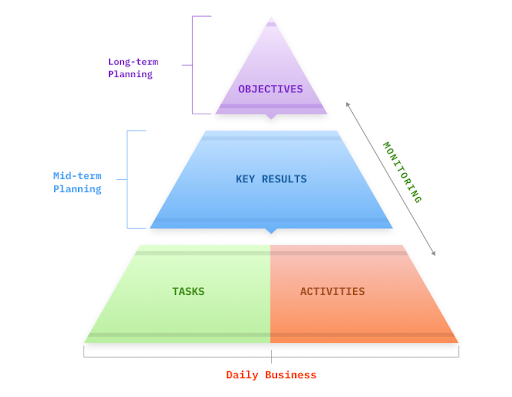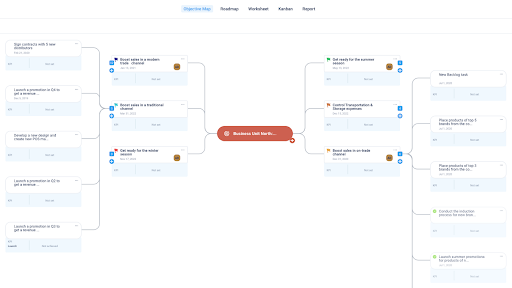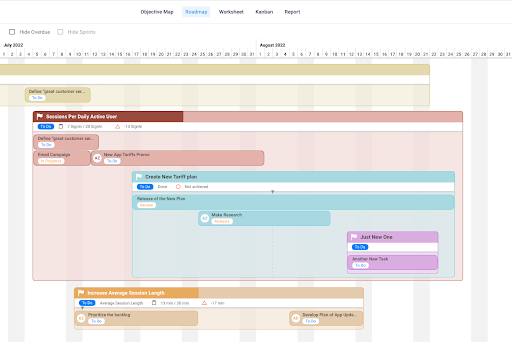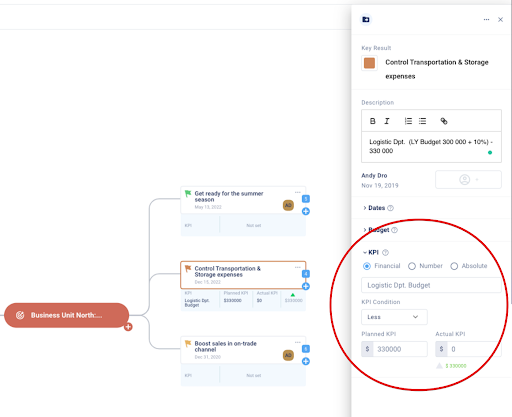OKR, which stands for Objectives and Key Results, is a business management method that helps you focus on achieving goals. With this approach, you will accomplish long-term, overarching, ambitious business goals (Objectives) through smaller, specific, measurable sub-goals (Key Results). Each Key Result has several associated Tasks (specific activities that must be performed to reach the Key Result).
What Challenges Teams Can Face and How OKR Approach Helps
Essentially, an Objective answers where we want to go, Key Results explain how we’ll know we’re getting there, and Tasks list the steps necessary to get there. And the OKR is the plan that brings it all together.
Below we offer two OKR tools: the Objective Map and the Roadmap. The Objective Map allows you to build a visual hierarchy of goals and plan objectives, while the Roadmap links this hierarchy of goals to a time factor.

The goal hierarchy is the heart of OKR.
OKR Planning Tool #1: The Objective Map
Our first tool is the Objective Map. The visual nature of this map allows you to see the whole picture at once, making it easy to analyze possibilities, predict obstacles, and plan objectives and the necessary resources for them. The Objective Map shows all factors (and how they are connected) that are needed for your success.

See all information on a map at once.
To create your own Objective Map, follow these steps:
- Identify and name your Objective. This is your long-term, overarching goal.
- Determine your Key Factors. These are the measurable sub-goals needed to achieve your Objective.
- Identify and name any possible obstacles you will face on the way to your Objective.
- List your Tasks. These are the specific steps to accomplish each Key Factor. Assign team members to these tasks.
- Create an Objective Map by plugging in the Key Factors and Tasks you’ve identified. Where appropriate, include your obstacle plans.
- Define your success metrics and connect them to your Objective and Key Factors.
- Review the Objective Map with your team to get buy-in and understanding.
The Objective Map is finished only once it provides answers to the following questions: where are you going, how will you get there, and what steps do you need to take along the way.
Tips for Creating an Objective Map
When creating your Objective Map, keep these tips in mind:
Tip #1: Name problems first, then make plans.
Take the time to brainstorm any obstacles that might come up on your way to plan Objectives. These obstacles can come in all shapes and sizes–from limited internal resources to external issues with your clients, product, or services. When you identify a potential obstacle, decide how you are going to address it before you set out on the journey towards your Objective.
Tip #2: Follow cause-and-effect logic.
It is important to have the Objective Map express the cause-and-effect connections between each element on the map (your Objective, Key Results, and Tasks). The best way to do this is to define success metrics for all factors. In other words, determine what success looks like for an activity (the cause) and connect that success to what happens next (the effect).
OKR Planning Tool #2: The Roadmap
The Roadmap is the tool you can use to determine the timeline, sequence, and deadlines of each step of your Objective Map. The Roadmap ensures that your team not only knows what they are doing but also when and in what order they will move through each step. Based on your goals, keep in mind that your team might be completing more than one step at a time. A Roadmap will help you identify those moments and prepare your resources accordingly.

The roadmap ends and begins with your Objective.
The steps of creating and using a Roadmap are:
- Revisit your Objective Map and review all the Key Results you’ve included in the map.
- Order each Key Result, and the Task activities that will get you to that result, in a logical sequence that moves towards your Objective.
- Assign due dates for each activity and step toward your Objective. If there is a hard end date, work backward from there when you plan Objectives.
- Revisit the Roadmap often to check-off completed steps and to prepare for the next steps.
- Revise the Roadmap when changing circumstances require you to pivot.

A Roadmap gives your team the awareness of projects in real-time.
Possible Challenges
Before we jump into a discussion of OKR creation, let’s review a few possible challenges that your team might face when creating a plan.
Problem #1: Unrealistic Views
Don’t succumb to wishful thinking by setting unrealistic goals. True, you want your Objective to be ambitious, but it also needs to be based on reality. Keep the assessment of your internal resources and capabilities, as well as any external factors, realistic.
Problem #2: Rigidity
The growth of your company depends on sustainability; sustainability depends on flexibility. When creating an OKR plan, don’t follow the plan so rigidly that the plan becomes (at best) useless or (at worst) harmful to your end goal. Always have the expectation that you may need to adjust to changing circumstances.
Problem #3: Lack of Motivation
The resources and technology you have access to are important, but it’s the people in your company that are key to your success. Avoid a lack of motivation by making sure each team member understands your business goals and agrees with their importance. This allows everyone to feel invested in a positive outcome and to use their creativity and energy to solve any emerging issues.
Conclusion
By using the Objective Map and Roadmap tools as your own OKR method, you will eliminate all the common problems that teams face when planning the road to a goal. These tools allow flexibility when obstacles arise; they also teach your team how to think about their own problem-solving thought process and the cause-and-effect relationships between each Key Factor. Fostering these qualities will ensure your team and your company will always be improving the practices and routines you use for achieving your goals. This is the key to success.

